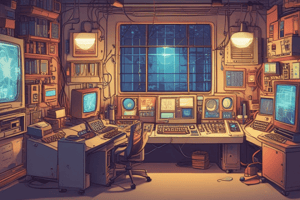Podcast
Questions and Answers
What is the primary function of the Arithmetic Logic Unit (ALU)?
What is the primary function of the Arithmetic Logic Unit (ALU)?
- Stores data temporarily
- Retrieves and executes instructions
- Provides power to the computer's components
- Performs mathematical operations (correct)
What type of memory is used to store data permanently?
What type of memory is used to store data permanently?
- Read-Only Memory (ROM) (correct)
- Cache Memory
- Hard Disk Drive (HDD)
- Random Access Memory (RAM)
Which device is used to capture video and images?
Which device is used to capture video and images?
- Mouse
- Webcam (correct)
- Microphone
- Scanner
What is the primary function of the Control Unit?
What is the primary function of the Control Unit?
What is the primary function of the Power Supply?
What is the primary function of the Power Supply?
What type of storage device stores data on interconnected flash memory chips?
What type of storage device stores data on interconnected flash memory chips?
What is the primary function of the Registers?
What is the primary function of the Registers?
Which device is used to print large-format graphics and designs?
Which device is used to print large-format graphics and designs?
What is the primary function of the Motherboard?
What is the primary function of the Motherboard?
What is the primary function of the Graphics Card?
What is the primary function of the Graphics Card?
Flashcards are hidden until you start studying
Study Notes
Hardware Components
Input Devices
- Keyboard: used for typing commands and data
- Mouse: used for pointing and selecting objects on the screen
- Scanner: used for scanning images and documents
- Webcam: used for capturing video and images
- Microphone: used for capturing audio
Processing Unit
- Central Processing Unit (CPU): executes instructions and performs calculations
- Arithmetic Logic Unit (ALU): performs mathematical operations
- Control Unit: retrieves and executes instructions
- Registers: small amount of memory built into the CPU
Memory
- Random Access Memory (RAM): volatile memory that stores data temporarily
- Read-Only Memory (ROM): non-volatile memory that stores data permanently
- Cache Memory: small, fast memory that stores frequently accessed data
Storage Devices
- Hard Disk Drive (HDD): non-volatile storage device that stores data on a physical disk
- Solid-State Drive (SSD): non-volatile storage device that stores data on interconnected flash memory chips
- Optical Drive: reads and writes data to optical discs (CDs, DVDs, Blu-rays)
- Flash Drive: portable storage device that stores data on a flash memory chip
Output Devices
- Monitor: displays video and images
- Printer: prints text and images on paper
- Speaker: produces audio output
- Plotter: prints large-format graphics and designs
Other Components
- Power Supply: provides power to the computer's components
- Motherboard: connects and supports the computer's components
- Graphics Card: controls the output display and performs graphical calculations
- Sound Card: controls the output audio and performs audio processing
Input Devices
- Keyboard is used for typing commands and data
- Mouse is used for pointing and selecting objects on the screen
- Scanner is used for scanning images and documents
- Webcam is used for capturing video and images
- Microphone is used for capturing audio
Processing Unit
Central Processing Unit (CPU)
- Executes instructions and performs calculations
- Consists of three main components: Arithmetic Logic Unit (ALU), Control Unit, and Registers
- ALU performs mathematical operations
- Control Unit retrieves and executes instructions
- Registers are small amount of memory built into the CPU
Memory
- Random Access Memory (RAM) is volatile memory that stores data temporarily
- Read-Only Memory (ROM) is non-volatile memory that stores data permanently
- Cache Memory is small, fast memory that stores frequently accessed data
- Cache Memory is used to speed up data access
Storage Devices
- Hard Disk Drive (HDD) is non-volatile storage device that stores data on a physical disk
- Solid-State Drive (SSD) is non-volatile storage device that stores data on interconnected flash memory chips
- Optical Drive reads and writes data to optical discs (CDs, DVDs, Blu-rays)
- Flash Drive is portable storage device that stores data on a flash memory chip
Output Devices
- Monitor displays video and images
- Printer prints text and images on paper
- Speaker produces audio output
- Plotter prints large-format graphics and designs
Other Components
- Power Supply provides power to the computer's components
- Motherboard connects and supports the computer's components
- Graphics Card controls the output display and performs graphical calculations
- Sound Card controls the output audio and performs audio processing
Studying That Suits You
Use AI to generate personalized quizzes and flashcards to suit your learning preferences.




